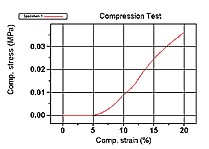A compression test determines behavior of materials under crushing loads. The specimen is compressed and deformation at various loads is recorded. Compressive stress and strain are calculated and plotted as a stress-strain diagram which is used to determine elastic limit, proportional limit, yield point, yield strength and, for some materials, compressive strength.

Why Perform a Compression Test?
The ASM Handbook®, Volume 8, Mechanical Testing and Evaluation states: "Axial compression testing is a useful procedure for measuring the plastic flow behavior and ductile fracture limits of a material. Measuring the plastic flow behavior requires frictionless (homogenous compression) test conditions, while measuring ductile fracture limits takes advantage of the barrel formation and controlled stress and strain conditions at the equator of the barreled surface when compression is carried out with friction.

Axial compression testing is also useful for measurement of elastic and compressive fracture properties of brittle materials or low-ductility materials. In any case, the use of specimens having large L/D ratios should be avoided to prevent buckling and shearing modes of deformation1."
The image at right shows variation of the strains during a compression test without friction (homogenous compression) and with progressively higher levels of friction and decreasing aspect ratio L/D (shown as h/d)1.

Modes of Deformation in Compression Testing
The figure to the right illustrates the modes of deformation in compression testing. (a) Buckling, when L/D > 5. (b) Shearing, when L/D > 2.5. (c) Double barreling, when L/D > 2.0 and friction is present at the contact surfaces. (d) Barreling, when L/D < 2.0 and friction is present at the contact surfaces. (e) Homogenous compression, when L/D < 2.0 and no friction is present at the contact surfaces. (f) Compressive instability due to work-softening material1.
Typical Materials
The following materials are typically subjected to a compression test.
- Concrete
- Metals
- Plastics
- Ceramics
- Composites
- Corrugated Cardboard
|